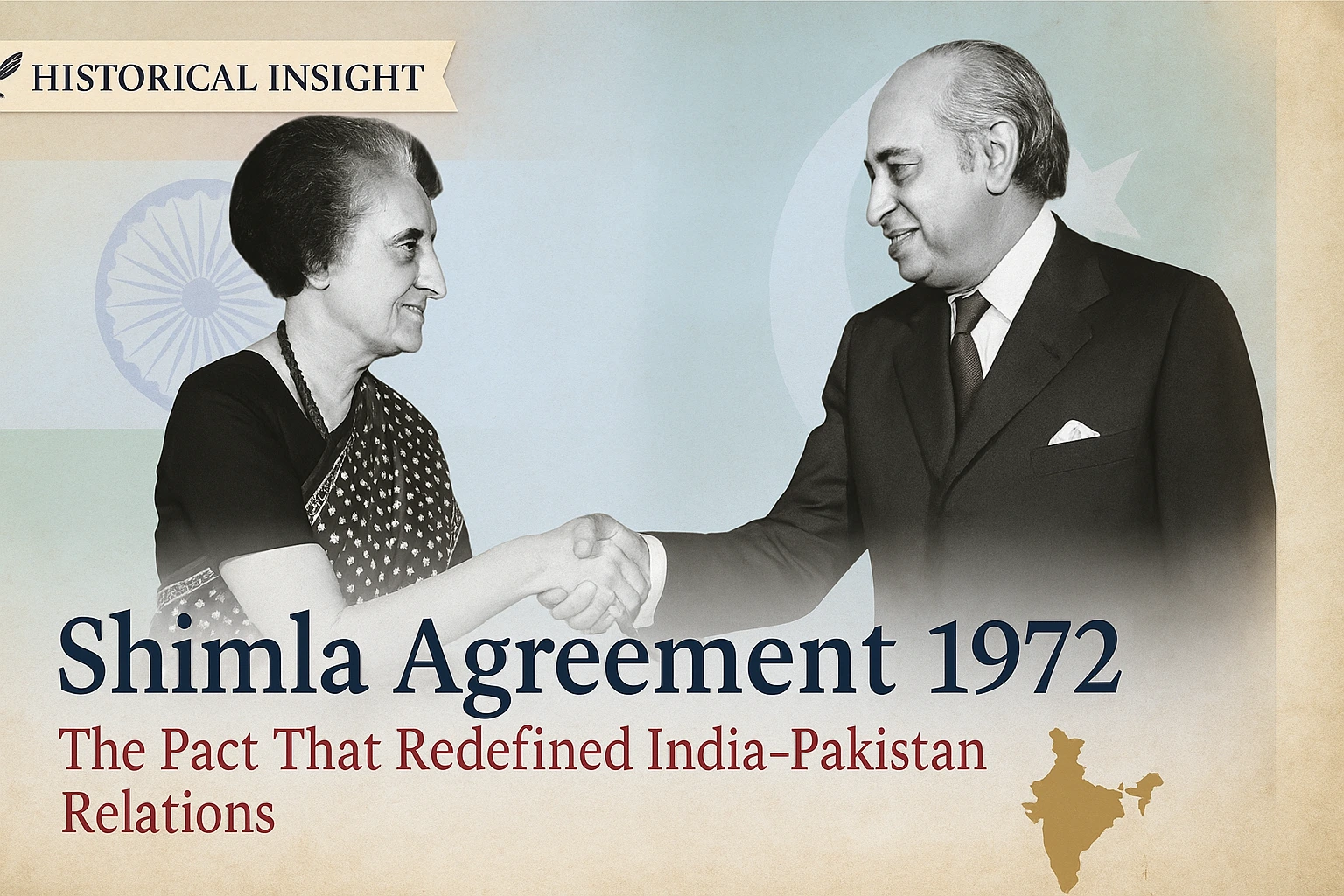The Shimla Agreement, signed on July 2, 1972, between India and Pakistan, remains one of the most significant diplomatic milestones in South Asian history. Emerging from the ashes of the 1971 war that led to the creation of Bangladesh, this treaty was designed to stabilize relations, establish boundaries, and outline peaceful conflict resolution strategies.
In today’s turbulent geopolitical landscape, understanding the roots and outcomes of this agreement helps contextualize present-day India-Pakistan dynamics.
Historical Context: Prelude to the Agreement–
The 1971 war resulted in a decisive victory for India and the secession of East Pakistan, now Bangladesh. In the wake of this conflict, both nations recognized the necessity of establishing a framework to prevent future hostilities. The Shimla Agreement was conceived to address this need, focusing on mutual respect, peaceful coexistence, and the resolution of disputes through dialogue.
To appreciate the importance of the Shimla Agreement, we must look at the events that led to it:
⚔️ The 1971 Indo-Pak War:-
- Sparked by political unrest and civil war in East Pakistan (now Bangladesh), India intervened in support of Bangladeshi independence.
- The war lasted 13 days and ended with the surrender of 93,000 Pakistani troops—the largest surrender since World War II.
- East Pakistan gained independence and became Bangladesh (Bangladesh Liberation War – Britannica).
🌍 Post-War Pressure and Global Diplomacy:-
- The international community, including the UN and major powers like the USSR and USA, urged both countries to negotiate peace.
- Both India and Pakistan were also motivated by economic stress and the need to normalize regional relations.
🕊️ Diplomatic Initiative:-
- The Shimla summit was hosted in India’s hill station of Shimla.
- Indira Gandhi (India) and Zulfikar Ali Bhutto (Pakistan) personally led negotiations to rebuild relations from scratch.
Key Provisions of the Shimla Agreement:-
1. Bilateral Resolution of Disputes:
Both countries agreed to resolve issues, including the contentious Kashmir dispute, through bilateral negotiations, thereby excluding third-party mediation.
- All disputes, including the Kashmir issue, would be resolved bilaterally.
- The non-involvement of third parties, including the UN, was clearly emphasized.
2. Respect for the Line of Control (LoC):
The agreement converted the ceasefire line in Jammu and Kashmir into the Line of Control, with both sides committing not to alter it unilaterally, irrespective of mutual differences and legal interpretations.
- The Ceasefire Line in Jammu & Kashmir was renamed as the Line of Control (LoC).
- Both countries agreed not to attempt altering it unilaterally, through force or any other means
3. Non-Interference in Internal Affairs:
India and Pakistan pledged to refrain from interfering in each other’s internal matters, promoting mutual respect for sovereignty.
- Each nation agreed to respect the sovereignty of the other.
- Political stability and mutual respiect were cornerstones for rebuilding trust.
4. Return of Prisoners of War (POWs):
- India returned more than 90,000 Pakistani POWs as a goodwill gesture.
- Pakistan recognized Bangladesh as a sovereign nation in return (UNHCR Report on POWs).
5. Restoration of Diplomatic and Economic Ties:
- Efforts were made to restore trade relations, transport links, and diplomatic engagement.
- This helped stabilize the subcontinent’s economic landscape.
6. Promotion of Peaceful Relations:
The treaty emphasized the development of friendly relations, including trade, communication, and cultural exchanges, to foster mutual understanding and cooperation.
Indus Waters Treaty: Reaffirmation Through Shimla Agreement–
💧 Background of the Indus Waters Treaty (1960):
- Brokered by the World Bank, the Indus Waters Treaty was signed between India and Pakistan in 1960.
- It allocated:
- Western Rivers (Indus, Jhelum, Chenab) to Pakistan
- Eastern Rivers (Ravi, Beas, Sutlej) to India
- Despite three wars, this treaty has remained largely unbroken and is seen as a model for water-sharing diplomacy
📜 Mention in the Shimla Agreement:
- The Shimla Agreement reaffirmed both countries’ commitment to existing bilateral agreements, including the Indus Waters Treaty.
- This ensured that water-sharing and river management would not be disrupted, even amidst heightened tensions.
✅ Why It Matters:
- Water is crucial for agriculture in both nations.
- Honoring the Indus Waters Treaty reflected a shared interest in regional stability and demonstrated that technical cooperation could transcend political conflict.
Impact and Legacy:-
The Shimla Agreement has been instrumental in shaping the diplomatic landscape of South Asia. It established a precedent for bilateral dialogue and has been referenced in subsequent negotiations and treaties. However, its efficacy has been challenged by recurring tensions and conflicts, particularly concerning the Kashmir region.
🟢 Positive Outcomes:
- Established a framework for peaceful negotiations
- Initiated a new diplomatic era post the 1971 war
- Helped maintain a fragile peace in the region for several decades
🔴 Challenges and Criticisms:
- The Kashmir issue remains unresolved
- Frequent ceasefire violations along the LoC
- Periodic breakdowns in diplomacy, including the Kargil conflict in 1999
Recent Developments: Suspension of the Shimla Agreement–
In April 2025, following a tragic attack in Pahalgam, Kashmir, which resulted in the deaths of 28 tourists, Pakistan announced the suspension of the Shimla Agreement. This move has significant implications for the stability of the region, as the agreement has long served as a framework for managing bilateral relations and maintaining peace along the LoC.
Conclusion: The Path Forward
The Shimla Agreement has been a cornerstone of India-Pakistan relations for over five decades. Its recent suspension underscores the fragility of peace in the region and the importance of sustained diplomatic engagement. As both nations navigate this complex landscape, revisiting the principles of the Shimla Agreement may offer a pathway to renewed dialogue and stability.
The Shimla Agreement remains a testament to diplomacy in the face of devastation. Its principles—respect for sovereignty, bilateralism, and peaceful dispute resolution—are still highly relevant. As South Asia confronts new political and environmental challenges, there’s a strong case to revive the spirit of Shimla for lasting peace.
FAQs:-
Q1: What was the primary objective of the Shimla Agreement?
The main goal was to establish a framework for peaceful bilateral relations between India and Pakistan, focusing on resolving disputes through dialogue and mutual respect.
Q2: How did the Shimla Agreement affect the status of Kashmir?
The agreement converted the ceasefire line into the Line of Control (LoC) in Jammu and Kashmir, with both nations agreeing not to alter it unilaterally.
Q3: Why did Pakistan suspend the Shimla Agreement in 2025?
Following a deadly attack in Pahalgam, Kashmir, Pakistan suspended the agreement, citing escalating tensions and accusing India of fomenting terrorism.
Q4: What are the implications of suspending the Shimla Agreement?
The suspension removes a key diplomatic framework that has helped manage conflicts and maintain peace along the LoC, potentially increasing the risk of escalated tensions between the two nations.
Q5: Where can I read the full text of the Shimla Agreement?
The complete document is available on the Ministry of External Affairs, India website.Ministry of External Affairs
For more insights into India-Pakistan relations and historical treaties, explore our related articles

Automotive industry analyst with 3+ years of experience dissecting market trends, emerging technologies, and consumer insights. His expertise fuels data-driven perspectives on swagatswork.com, empowering professionals to navigate the evolving automotive landscape.
